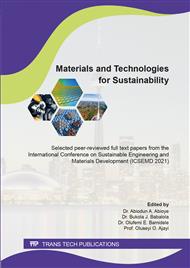[1]
Z.Helwani, M.R. Othman, N. Aziz, W. J. N. Fernando, J.Kim, Technologies for production of biodiesel focusing on green catalytic techniques: A review, Fuel Process. Technol. 90, 12(2009) 1502–1514.
DOI: 10.1016/j.fuproc.2009.07.016
Google Scholar
[2]
S.O. Bitire, T.C. Jen, M. Belaid, The Potential for a Sustainable Biodiesel Production by Modified Biobased Catalyst–A review, IOP Conf. Ser. Mater. Sci. Eng.1107, 1 (2021) 12206.
DOI: 10.1088/1757-899x/1107/1/012206
Google Scholar
[3]
L.Brennan, P.Owende, 'Biofuels from microalgae-A review of technologies for production, processing, and extractions of biofuels and co-products, Renewable and Sustainable Energy Reviews. (2010).
DOI: 10.1016/j.rser.2009.10.009
Google Scholar
[4]
S.O. Bitire, M. Belaid, P. E. Imoisili, T.C. Jen, Parametric Optimization Route of Oil Extraction from Seed: A Review, IOP Conf. Ser. Mater. Sci. Eng. 1107, 1(2021) 12150.
DOI: 10.1088/1757-899x/1107/1/012150
Google Scholar
[5]
J. Janaun, N. Ellis, Perspectives on biodiesel as a sustainable fuel, Renewable and Sustainable Energy Reviews, 14, 4 (2010) 1312–1320.
DOI: 10.1016/j.rser.2009.12.011
Google Scholar
[6]
A. Demirbas, Biodiesel production via non-catalytic SCF method and biodiesel fuel characteristics,, Energy Convers. Manag., 2006,.
DOI: 10.1016/j.enconman.2005.11.019
Google Scholar
[7]
A. Mert, M. Timur, Essential oil and fatty acid composition and antioxidant capacity and total phenolic content of parsley seeds (Petroselinum crispum) grown in Hatay Region, Indian J. Pharm. Educ. Res. (2017).
DOI: 10.5530/ijper.51.3s.63
Google Scholar
[8]
S.O. Bitire, T.C. Jen, M. Belaid, Transesterification of parsley seed oil using a green catalyst: considering the optimization process and modeling, Int. J. Sustain. Energy. (2021).
DOI: 10.1080/14786451.2021.1890737
Google Scholar
[9]
Y. Zhang, M. A. Dubé, D. D. McLean, M. Kates, Biodiesel production from waste cooking oil: 1. Process design and technological assessment, Bioresource Technology. (2003).
DOI: 10.1016/s0960-8524(03)00150-0
Google Scholar
[10]
T.C. Venkateswarulu et al., Review on methods of transesterification of oils and fats in bio-diesel formation, Int. J. ChemTech Res. 6, 4 (2014) 2568–2576.
Google Scholar
[11]
L.C. Meher, D. Vidya Sagar, S.N. Naik, Technical aspects of biodiesel production by transesterification - A review, Renewable and Sustainable Energy Reviews. (2006).
DOI: 10.1016/j.rser.2004.09.002
Google Scholar
[12]
S.O. Bitire, T.C. Jen, M. Belaid, Synthesis of beta-tricalcium phosphate catalyst from Herring fishbone for the transesterification of parsley seed oil, Environ. Technol. (United Kingdom). (2021).
DOI: 10.1080/09593330.2021.1916094
Google Scholar
[13]
N. Hoda, Optimization of biodiesel production from cottonseed oil by transesterification using NaOH and methanol, Energy Sources, Part A Recover. Util. Environ. Eff. 32, 5 (2010) 434–441.
DOI: 10.1080/15567030802612168
Google Scholar
[14]
W.A. Kawentar, A. Budiman, Synthesis of biodiesel from second-used cooking oil, Energy Procedia. 32 (2013) 190–199.
DOI: 10.1016/j.egypro.2013.05.025
Google Scholar
[15]
A. Bouaid, R. Vázquez, M. Martinez, J. Aracil, Effect of free fatty acids contents on biodiesel quality. Pilot plant studies, Fuel. (2016).
DOI: 10.1016/j.fuel.2016.01.018
Google Scholar
[16]
S. Sani, M. U. Kaisan, D. M. Kulla, A. I. Obi, A. Jibrin, B. Ashok, Determination of physico chemical properties of biodiesel from Citrullus lanatus seeds oil and diesel blends, Ind. Crops Prod. (2018).
DOI: 10.1016/j.indcrop.2018.06.002
Google Scholar
[17]
S.O. Bitire, T.C. Jen, M. Mohammed, Transesterification of Parsley Seed Oil using a Green Catalyst: Considering the Optimization Process and Modeling, Int. J. Sustain. Energy. (2021). doi: https://doi.org/10.1080/14786451.20 )., 21.1890737.
DOI: 10.1080/14786451.2021.1890737
Google Scholar
[18]
W.N.M. Wan Ghazali, R. Mamat, H. H. Masjuki, G. Najafi, Effects of biodiesel from different feedstocks on engine performance and emissions: A review, Renewable and Sustainable Energy Reviews. (2015).
DOI: 10.1016/j.rser.2015.06.031
Google Scholar
[19]
P. Hellier, N.Ladommatos,T. Yusaf, The influence of straight vegetable oil fatty acid composition on compression ignition combustion and emissions', Fuel. (2015).
DOI: 10.1016/j.fuel.2014.11.021
Google Scholar
[20]
B.Ashok, K. Nanthagopal, Eco friendly biofuels for CI engine applications, in Advances in Eco-Fuels for a Sustainable Environment. (2019).
DOI: 10.1016/b978-0-08-102728-8.00015-2
Google Scholar
[21]
A. Purandaradas, T.Silambarasan, K. Murugan, R. Babujanarthanam, D.Gandhi,V. Dhandapani, D.Anbumani, P Kavitha, Development and quantification of biodiesel production from chicken feather meal as a cost-effective feedstock by using green technology, Biochem. Biophys. Reports. (2018).
DOI: 10.1016/j.bbrep.2018.04.012
Google Scholar


